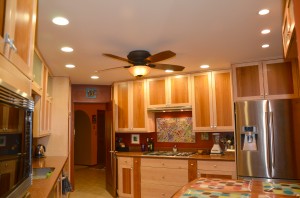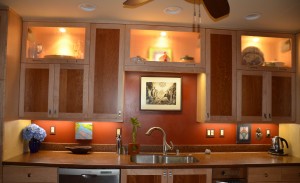(Updated January 2016)
Whether one is doing a kitchen remodel or starting from scratch, the lighting design is frequently the last thing considered and often the first thing to get cut from the budget. Lighting design and planning should be phase 1 of a kitchen project whether you are starting from scratch or remodeling. If you want your lighting to look like it was done by a pro, choosing the right light and the right placement of the light will make all the difference in the world. To avoid headaches, hassles and driving your project cost up unnecessarily, the lighting decisions need to occur in the initial stage of the project and not as a 'hindsight is 20-20' kind of thing.
What are the aspects that need to be considered in making these decisions? Lighting designers say that using three types of lighting functions is paramount to good lighting design-whether it is in your kitchen or elsewhere. It is a 'layering' technique:
- General or ambient light source: this is the primary and central source of lighting that provides overall illumination. Think of this as the general lighting that allows you to move about in the space safely and allows you to perform general tasks.
- Best choices for general lighting: ceiling and wall mounted fixtures, recessed lights.
- Task lighting: lighting that allows you to perform specific tasks such as, food preparation, reading, cooking, etc. Effective task lighting should not have distracting glare and shadows and make sure that it is bright enough to avoid eyestrain.
- Best choices for task lighting: recessed, pendant lights, under the cabinet lighting, floor and table lamps.
- Drama/accent/focal lighting: lighting that is used to introduce elements of drama or accent by bringing the viewer’s attention to something in particular-such as artwork, plants a wall, etc. How to make focal lighting work effectively? Make sure the light on the focal point (object) is three times brighter than your general lighting source around it.
- Best choices for focal lighting: recessed lights, track lights.
Some Thoughts on Dimming Systems
Some designers like to incorporate dimming systems in their lighting design. Our designer recommends that dimming systems be avoided in most cases-with the exception of dining rooms and media rooms. Here are some reasons why a dimming system should be avoided: 1) color temperature shifts (if you are not using a LED lamp) 2) bulb does not dim in the full range and will drop out around 15-20% (common with LED lamps) 3) flickering. Halogen bulbs experience color temperature shifts when being dimmed-not to mention that they require more energy to run and create unwanted heat. Fluorescent bulbs do not have a filament-which translates to it not being conducive to being dimmed-they drop out at 15-20%-which in turn, does not give you the full range. Fluorescent bulbs will also flicker when being dimmed. LEDs do not have a filament either, and suffer from the same things that fluorescent bulbs do; dropping out at 15-20% and flickering. Flickering is a bigger deal than one would initially think: it can cause neurological disturbances, headaches, fatigue, eye strain, affects your perception of motion and is a distraction, to name a few of the problems. As technology changes, the LED are becoming more easily dimmed, but we like to reserve dimming for where dimming is actually needed. Hopefully, we've succeeded in talking you out of using a dimming system.
You can achieve a more pleasing effect by using the layering technique-not to mention that it looks professional. You can also keep your lighting costs down by using fixtures that can perform multiple functions.
General Light Source
6" recessed cans are a great choice for the general lights-and will give you the most choice by way of lamps/bulbs that fit into the fixture. When I did a kitchen remodel in my own home in 2008, LED lights for 6" recessed had just been introduced to the market. Yes, initially, LED bulbs cost more than their counterparts, but now with the changes in LED technology, prices have dropped down to where they are more than affordable. The new LED bulbs provide up to 60,000 of continuous light that is cool burning and instant on. No other bulb can do that! LED is also the most 'green' choice you can make in keeping your carbon footprint minimized. Initially, we tried out LED bulbs that had a color temperature of 27K. We found these to look too 'yellow' and ended up going with a brighter, slightly cooler color temperature of 30K. Much better! You can go up to as high as 4100K. We found that the 5000K and above is just to white of a light for use in a home-to the point where your eyes see it as blue.

Here is an example in my kitchen with just some of the recessed lights on-this is my 'everyday' lighting choice. The lights are LED bulbs in 6" recessed cans (my camera did yield some unwanted lens flare from pointing up in to the lights-those reflections are not really there on the ceiling).
 In this example of my kitchen lighting, I have all of the recessed lights on. All decisions for the lighting source and placement were intentional. We looked for a light that had a broad, white, diffused, bright, even light-one that did not have 'edges' to the beam spread. This reduces the shadows on the work surfaces and the amount of glare. The LED lights we chose met that criteria. Track lighting was not a good choice because it is harsh, directional and creates lots of shadows. It wasn't appropriate for our application (you might have call for a directional light in your kitchen layout, however).
In this example of my kitchen lighting, I have all of the recessed lights on. All decisions for the lighting source and placement were intentional. We looked for a light that had a broad, white, diffused, bright, even light-one that did not have 'edges' to the beam spread. This reduces the shadows on the work surfaces and the amount of glare. The LED lights we chose met that criteria. Track lighting was not a good choice because it is harsh, directional and creates lots of shadows. It wasn't appropriate for our application (you might have call for a directional light in your kitchen layout, however).
My lighting designer wanted all my work surfaces to be evenly lit. Notice the distance of the recessed lights in relation to the cabinets. They are place 18" out from the cabinets so that it would light the cabinets and allow the light to light the inside of the cabinet when opened. This distance also minimized shadows cast in the area of the work space when standing at the counter. The space between each recessed light is about 2 feet-allowing for a well lit room. Notice too, that one is placed over the doorway.
Look carefully at the bank of recessed lights above the table (far top right of image). These are 4" LED Modules just like we used in the 6” housing. Using the 4" housing and module also breaks things up and adds interest-we didn't need as much light over the table area.
With the 6"recessed cans, our lighting designer put them on two switches so that you could just have some on and at other times, have them all on when you want it to be brighter. That provided two levels of general lighting.
Task Lighting
The next layer of lighting in my kitchen is task lighting. Right above my kitchen sink is a light to provide me with an additional layer of light-by way of a LED under cabinet fixture.
 An additional LED under cabinet light fixture over the kitchen sink for additional task lighting (I turned the general lighting off so that you can see this light source better - we have a full video on the new LED under cabinet fixture at this link)
An additional LED under cabinet light fixture over the kitchen sink for additional task lighting (I turned the general lighting off so that you can see this light source better - we have a full video on the new LED under cabinet fixture at this link)
 Task lighting over the stove top area achieve by way of halogen MR-16s
Task lighting over the stove top area achieve by way of halogen MR-16sAccent Lighting (for added drama)
Accent lighting in my kitchen was achieved by way of additional fixtures under the cabinets The LED under the cabinet fixture is a great choice over a fluorescent since it lasts longer, is more energy efficient AND has a lower profile. Not to mention that the color rendering is much better. The LED under the cabinet is a specular light source-it gives an added dimension that a fluorescent bulb cannot. Think of it as adding more 'bling'.
 Under cabinet lighting
Under cabinet lighting LED under cabinet & cabinet lights
LED under cabinet & cabinet lightsPictured here are the LED under the cabinet lights and LED cabinet lights in the upper cabinets.
Of course, it goes without saying, that if you have natural light to work with, by all means incorporate that in to your lighting design. Natural light always makes a home more appealing. When trying to achieve natural lighting with lighting fixtures, be sure to use bulbs that are described as 'daylight' instead of those described as warm-that way the color temperature is more closely matched.
Hopefully, by sharing what went in to the decision making process for lighting choices in my kitchen remodel, you will have at least a better starting point. Avoid using a dimming system and avoid trying to light the entire room with just one light source such as a ceiling mounted fixture. Please feel free to contact us for solutions to your lighting challenges-we are here to help!
If you found this article to be helpful, please send us your before and after photos and a brief description of your experience-we'd love to share your success story!
